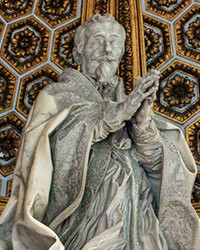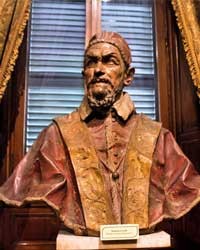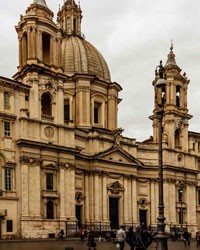Domenico Guidi’s The Lamentation – dramatic pathos, a throng of people, and movement
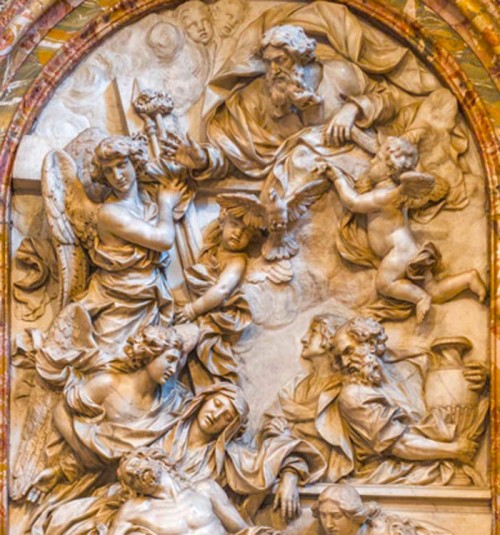
Domenico Guidi’s The Lamentation, fragment, Domenico Guidi, Monte di Pietà Chapel
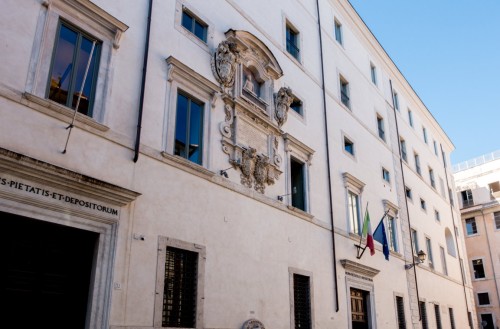
The facade of the Monte di Pietà palace, which houses the chapel Monte di Pietà
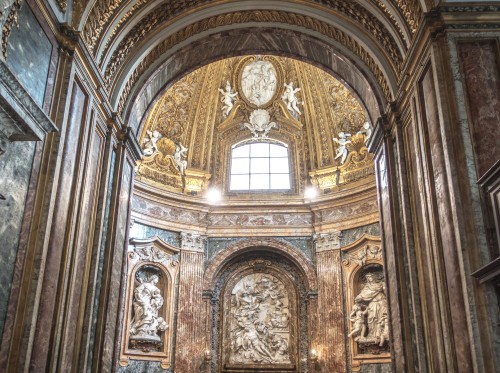
The interior of the Monte di Pietà Chapel (Palazzo Monte di Pietà)
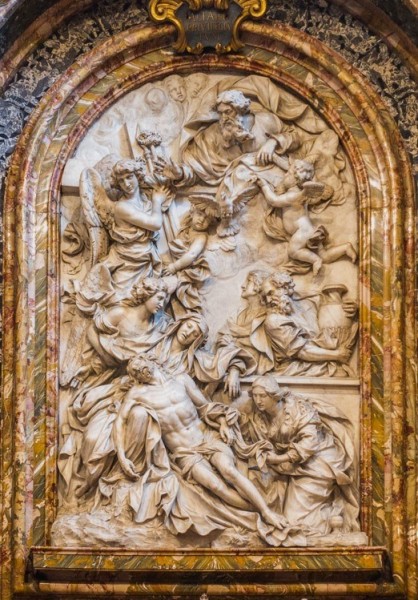
Domenico Guidi’s The Lamentation, Domenico Guidi, Monte di Pietà Chapel
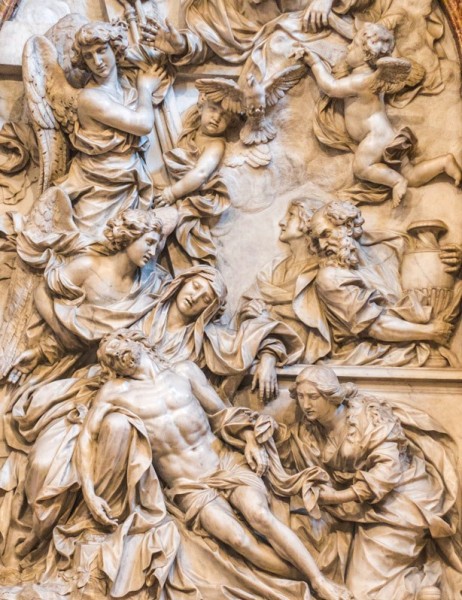
The Lamentation, fragment, Domenico Guidi, Monte di Pietà Chapel
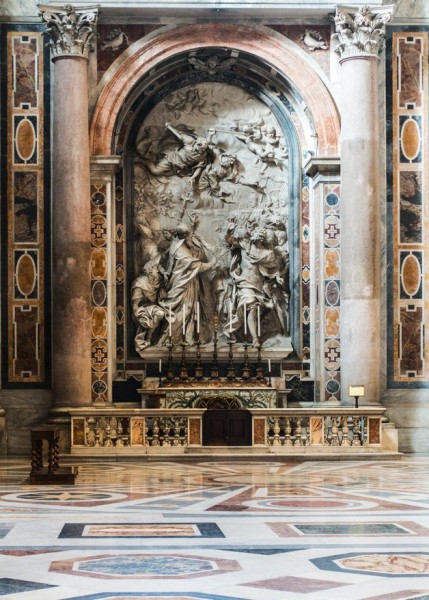
The Meeting of Leo I and Attila, Alessandro Algardi, San Pietro in Vaticano

The Holy Family, Domenico Guidi, Church of Sant’Agnese in Agone
In 1648, the 23-year-old at that time Domenico Guidi arrived in the Eternal City. He had to leave his hometown of Naples, due to the riots connected with Neapolitan Rebellion, in which he actively took part. He was already well-versed in sculpture thanks to his uncle Giuliano Finelli, in whose workshop he had been working until then. This relationship most likely proved to be a great trump card for an artist searching for commissions in Rome, but it could have also been a hindrance. This is due to the fact that the artistic community of the city was ruled by Gian Lorenzo Bernini – he was the one handing out commissions and managing the sculptural and architectural works, as he enjoyed the nearly limitless trust of subsequent popes. Finelli, who began his career in Bernini’s workshop left Rome after a falling out with the great sculptor. That is why Guidi’s situation was uncertain, not only because Bernini was vindictive, but also because quarrels and animosities in the then-artistic community were treated deadly seriously in the literal sense of the words.
In 1648, the 23-year-old at that time Domenico Guidi arrived in the Eternal City. He had to leave his hometown of Naples, due to the riots connected with Neapolitan Rebellion, in which he actively took part. He was already well-versed in sculpture thanks to his uncle Giuliano Finelli, in whose workshop he had been working until then. This relationship most likely proved to be a great trump card for an artist searching for commissions in Rome, but it could have also been a hindrance. This is due to the fact that the artistic community of the city was ruled by Gian Lorenzo Bernini – he was the one handing out commissions and managing the sculptural and architectural works, as he enjoyed the nearly limitless trust of subsequent popes. Finelli, who began his career in Bernini’s workshop left Rome after a falling out with the great sculptor. That is why Guidi’s situation was uncertain, not only because Bernini was vindictive, but also because quarrels and animosities in the then-artistic community were treated deadly seriously in the literal sense of the words.
Guidi immediately went to Alessandro Algardi. The artist had by then already been quite ill and due to his weight had difficulties in moving, but he was the only sculptor in town independent of Bernini. Guidi was employed in his workshop and quickly proved his worth. This took place, while Algardi was working on a prestigious commission – an altar commemorating Pope Leo I in the Basilica of San Pietro in Vaticano (The Meeting of Leo I and Attila). This bas-relief of huge dimensions was the flagship work of Algardi, who unfortunately troubled by gout had to stop working, entrusting all the tasks to his collaborators, among whom were Ercole Ferrata and the newly employed Guidi. As anecdote would have it, the ailing master left his bed after a few months to see the work entrusted to him and was taken back by the speed and quality of the work of his students. In subsequent years the young sculptor accompanied Algardi in commissions, all the way until his death in 1654. Then, he took over the works of his master and received his own commissions – fashionable at that time busts. One of these was that of Cardinal Charles Borromeo in the del Monte di Pietà Chapel (Palazzo Monte di Pietà). In 1658 the funders of the bust (The Archconfraternity of Santa Maria del Sacro Monte di Pietà), pleased with the work decided to entrust the artist with a much more ambitious task – the creation of the main altar in the same chapel. In November of 1659, a contract was signed to create a bas-relief altar within a period of two years for a rather large sum of 1800 scudos. A marble block 4 by 2 meters was brought from Carrara and the artist began to create a model to present it to his clients. However, the following year the works were halted at the behest of Pope Alexander VII, who claimed that the chapel was a place which should symbolize the virtue of poverty and should serve the needy and thus it was much too richly furnished and ostensibly luxurious. Ultimately Guidi did not complete the bas-relief until ten years later in 1676, when Pope Innocent IX assumed the papal throne.

Guidi’s monumental work showing The Lamentation most likely pleased his clients and fit in perfectly with the bombastic interior of the chapel. Its composition was divided into three parts. In the upper part, we can see God the Father, surrounded by putti and angels holding the tools of the passion of the Son of God (cross, spear, sponge), and a dove – the symbol of the Holy Spirit. Below is Our Lady mourning her son, next to her Joseph of Arimathea and St. John. In the lower part, the martyred body of Christ can be seen, along with the grieving Mary Magdalena. Skillfully the artist created an arch stretching from the head of God the Father all the way to the head of Mary Magdalene. It is this very arch that introduces movement into the composition, which is somewhat stabilized by the horizontal line of the wall, behind which we can see Joseph observing Our Lady and St. John looking up at the heavens. However, that is not all – the artist grades the feeling of depth in his bas-relief in a varied way bringing out the individual figures and events out of the marble. Some elements (heads, hands, draperies) fully plastically sculpted come out to meet the viewer, others make up the background, although it is quite extensive. Further still are the barely visible clouds. In order to further enrich the composition, Guidi very extensively (too extensively from today’s point of view) used draperies, multiplied details, and fine-tuned every single detail of the hair and feathers, but most of all the robes, in this way “capturing” the light reflecting from their highly polished surfaces. On the other hand, he was able to bind the light into the non-polished parts of rocks, plants, and clouds, due to which the composition becomes even more chromatic.

From today’s point of view, it seems as if the artist had wanted to tell us too much at once. The various plots and scenes superimpose upon one another and intertwine. The altar seems to be overfilled and difficult to understand, but for Guidi's contemporaries, it was an ideal work, dramatic in its expression. The ambitious sculptor most likely, wanted to create a work worthy of this talent, but also an artistic response to the decoration of his adversary – Bernini. This was because Gian Lorenzo considered sculpture to be the greatest of artistic creations, depreciating the more and more fashionable at that time bas-reliefs, which according to him were reminiscent of painting which he did not hold in high regard. For Bernini sculpture was pure truth, while painting was a “lie”. Guidi comes into dialogue with Bernini, aiming to show that his work may be a bridge between the two genres, may combine them, and creatively assimilate them.

In time Guidi gained more and more renown in the community of Roman sculptors, which was testified to by the numerous, ever-flowing commissions. He, similarly to other significant artists of those times, was forced to increase the number of his collaborators and students, which unfortunately had a negative impact on his works – unfinished compositions that were of poor quality. This is visible in another, very similar to the discussed altar, work which the artist undertook immediately after finishing his work in the del Monte di Pietà Chapel. This time it was the main altar in the Church of Sant’Agnese in Agone depicting the Holy Family accompanied by St. Elizabeth, Zechariah, and St. John the Baptist. A truly overloaded work, is proof of the fact that popularity and fame may as a consequence lead to artistic imprisonment.



















